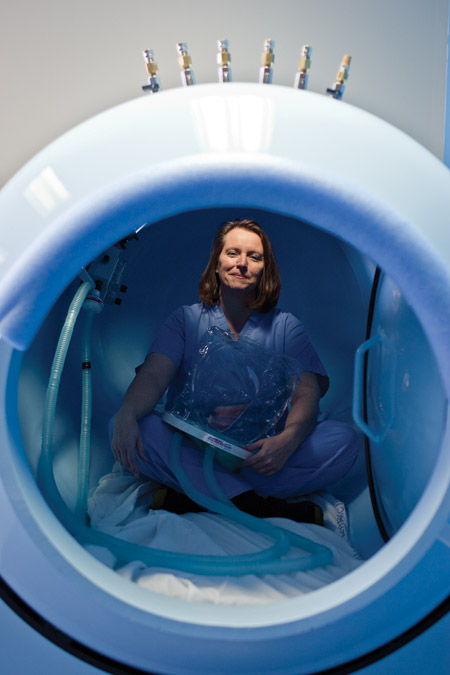
Writer Cyd Haynes experiences a blast of O2.
A hyperbaric chamber of secrets stirs deep healing through oxygen therapy.
I’m told to wear only cotton and offered light blue scrubs to change into. Off come my necklace, bracelet and small silver hoop earrings. Clothing causes friction, friction causes sparks, sparks cause explosions. I got it.
The breast pocket and right thigh read “HYPERBARIC UNIT” in capital letters. I’ve come just over the western border of Edina to the Minnesota Hyperbaric Treatment Center to experience what few others get near—a hard-sided hyperbaric oxygen chamber.
A seven-by-four-foot capsule is about to take me on an adventure into the world of healing, by way of oxygen saturation. I’ll be allowed to experience the pressure of 1.5 atmospheres, sans the oxygen, since I do not have a certifiable condition that warrants a ‘script.’
Scuba divers have long used Hyperbaric Oxygen Therapy (HBOT) to counteract gas bubbles trapped in the bloodstream when their ascent to the surface has been too rapid (commonly known as the “bends”). Hyperbaric treatments are also referred to as “dives,” and a typical therapy calls for 20 to 40 of them.
Conditions treated by HBOT most often include autism, strokes, cerebral palsy and brain injuries, and have proven to be beneficial for carbon monoxide poisoning, certain infections, crush injuries, acute burns and diabetic wounds. The center also treats conditions which show clinical data supporting HBOT’s efficacy, including autism and traumatic brain injury. I am thankful to not need such a ‘script’—today anyway.
Chamber technician John Byington walks me through the process. He’s a practiced hand at regulating the chamber and easing the transition into an unknown experience. He says most kids grow to love it and don’t want to leave.
The first and second chambers in the room are equipped with an exterior sound system and video player to help pass the time, which usually involves one hour at full pressure, bracketed by 15 minutes of compression and decompression time on either side. I’m surprised when told that a child and therapist are presently in the chamber. The slight hissing of valves gives them away.
The center treats adults, and kids under age 13 accompanied by a therapist or parent. “One girl had ongoing, severe migraines after a concussion,” says Byington. “Her neurologist saw great improvements from the therapy.” He also tells me of a stroke victim who, at the beginning of treatment needed assistance to get around. By the end of his series of dives, he climbed out by himself and said, “I feel like I’m actually alive!”
Anxious to feel alive, I try on the clear oxygen hood and crawl in. The hatch closes behind me with a soft thud. The sky blue chamber walls are slightly cool to the touch but a comfortable pad, covered by sheets and a pillow, provides warmth. I sit, looking around, and then lie down.
Light streams in through three, eight-inch portholes. Byington’s shadow curves along the inside of the chamber as he moves around adjusting valves and knobs—or whatever he’s doing out there. I hear his muffled voice say, “Ok, the pressure’s on.”
White noise of air flowing and my ears immediately begin to gently pop. I’m not claustrophobic but I can see where someone might feel a bit “closed in.” This is the familiar feeling of ascent in an airplane.
Beyond the hissing, the outside world fades. After 15 minutes Byington gives me the thumbs-up sign and the waiting begins.
Through two portholes I see white ceiling tiles, the other is filled by an ocean blue wall. I half imagine fish swimming by. My mind floats from story deadlines to grocery lists to .… I see the pathways of a video game maze on the back of my eyelids. I roll over and nod off— the height of investigative reporting.
Healing comes in many forms. In this case, breathing 100 percent oxygen at greater than normal atmospheric pressure, causes an increase in the amount of oxygen dissolved in the blood. High concentrations of oxygen support healing in wounds, stimulating new blood vessels, improving white blood cell function and decreasing swelling.
Dr. Michael Montico, medical director at the center, says that pressure also drives oxygen into the platelets of the blood, which can get into smaller places, where red blood cells can’t go. “The good news is…oxygen is safe,” he shares, “and the awareness of hyperbaric therapy is rising exponentially.”
White noise starts up again as decompression begins like air slowly leaking out of a balloon. The popping in my ears increases slightly as the noise fades to a stop and the seal around the door is broken. As I climb out I do feel a bit more alive—able to breathe deeply. Hopefully a serious ailment or trauma will not land me here, but I’d dive again in a heartbeat if needed. Non-invasive healing options are refreshing to find.
MN Hyperbaric Treatment Center, 10273 Yellow Circle Dr., Minnetonka; 952.401.9359
Until hyperbaric oxygen therapy comes into wider use, you can experience the effects of 94 percent concentrations of breathable oxygen in the relaxed setting of Zen Experience Spa in Southdale Center. Whether it’s in preparation for athletic activity, for stress reduction or a simple energy boost, recreational oxygen is said to promote a calmer mind, better health and healing. 1675 Southdale Center; 952.922.3600
Edina chiropractor Dr. Aaron Flickstein also employs oxygen therapy in his practice of making patients pain free and increasing brain function.
5200 Willson Rd., Suite 150; 952.925.2225





















